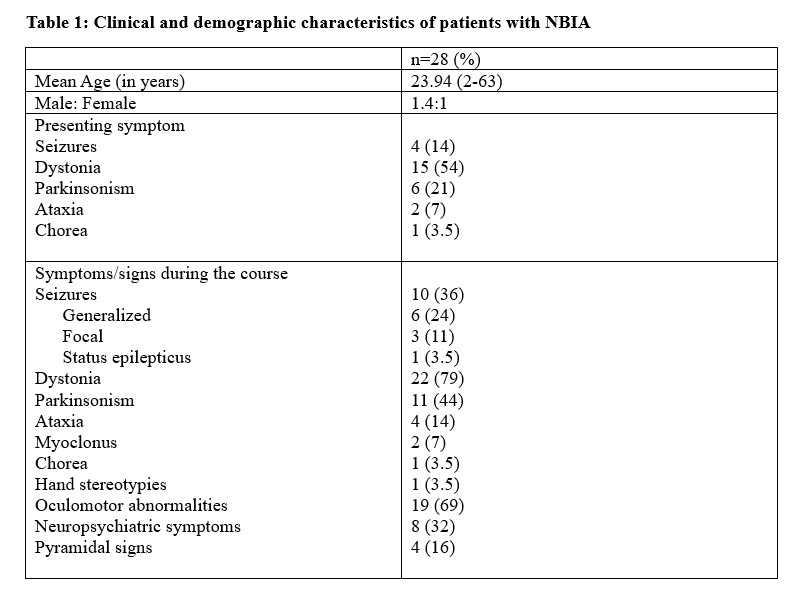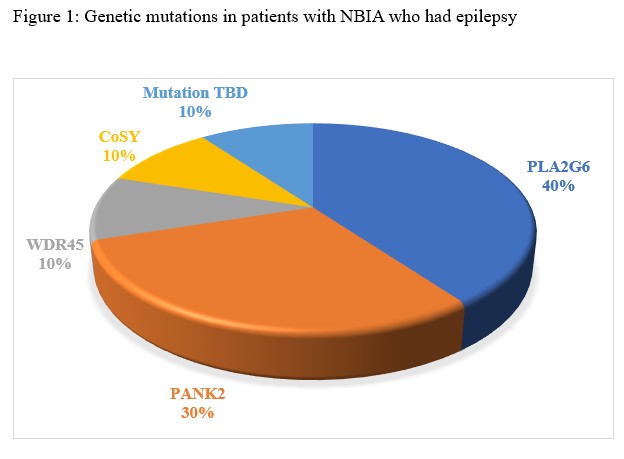Category: Rare Genetic and Metabolic Diseases
Objective: To investigate the frequency and pattern of seizures in Neurodegeneration with brain iron accumulation (NBIA) disorders in a South Indian cohort.
Background: Seizure as a clinical manifestation can occur in NBIA [1] but the data is sparse.
Method: 28 subjects from a tertiary care center, with pyramidal/ extra pyramidal dysfunction, neuropsychiatric abnormalities and seizures with magnetic resonance imaging showing evidence of iron in brain were included. Additional investigations including blood sugar estimation, serum ceruloplasmin, smear for acanthocytes, ferritin levels, EEG, fundus examination, nerve conduction study and neuropsychological assessment were performed based to the presentation. Targeted gene or clinical exome sequencing was done for NBIA.
Results: 20/28 were males. Clinical onset varied from 2-63 years (23.94±17.71) with family history being positive in seven patients. Seizure was the first symptom in 4 patients, one of whom presented with status epilepticus. Initial symptom was dystonia in 15, parkinsonism in 6, ataxia in 2 and chorea in 1. (Table 1) Over the course total 10 (36%) had epilepsy and other manifestations included dystonia (22), parkinsonism (11), ataxia (4), myoclonus (2), chorea (1), hand stereotypies (1). Oculomotor abnormalities (19) especially slow saccades was the most common associated feature, followed by neuropsychiatric symptoms (8), and pyramidal signs (4). On susceptibility weighted images (SWI) all had iron in globus pallidus, with additional substantia nigra (SN 9), red nucleus (RN 9) or combined RN, dentate nucleus (DN) and striatum (3). Of the 10/28 NBIA patients (36%) with seizures mutations were detected in PLA2G6 (4), PANK2 (3), WDR45 (1) and CoSY (1) (Figure 1). Of the 10 patients, 1 tested negative for NBIA targeted gene sequencing. 6 patients had generalised and 3 had focal seizures while 1 presented with status epilepticus.[2] EEG showed generalised or central discharges.
Conclusion: PLA2G6 associated neurodegeneration (PLAN) was the most common NBIA to clinically present with seizures followed by PKAN, BPAN, and CoPAN. Eye movement abnormalities and dystonia aid in identifying NBIA when subjects present with seizures.
References: [1] Emamikhah M, Saiyarsarai P, Schneider SA et.al Seizure in Neurodegeneration with brain iron accumulation: A Systematic Review. Can J Neurol Sci. 2022 Jan 24:1-29.
[2]Ajit, V.K., Selvaraj, P., Divya, K. et al. Status Epilepticus in Coenzyme A Synthase Protein-Associated Neurodegeneration – Expanding the Clinical Phenotype. Indian J Pediatr (2023). https://doi.org/10.1007/s12098-023-04515-x
To cite this abstract in AMA style:
D. Kalikavil Puthanveedu, A. Cherian. Prevalence of seizures in patients with Neurodegeneration with Brain Iron Accumulation [abstract]. Mov Disord. 2023; 38 (suppl 1). https://www.mdsabstracts.org/abstract/prevalence-of-seizures-in-patients-with-neurodegeneration-with-brain-iron-accumulation/. Accessed April 1, 2025.« Back to 2023 International Congress
MDS Abstracts - https://www.mdsabstracts.org/abstract/prevalence-of-seizures-in-patients-with-neurodegeneration-with-brain-iron-accumulation/


